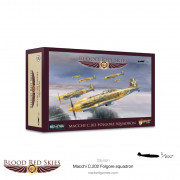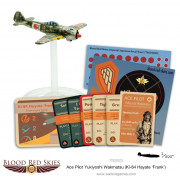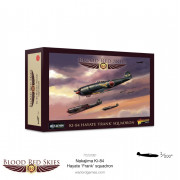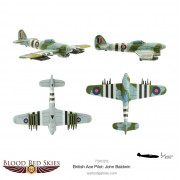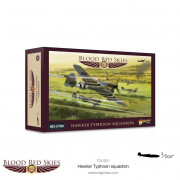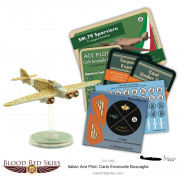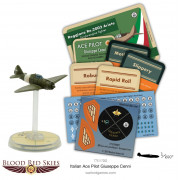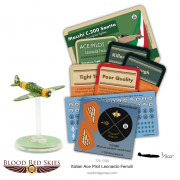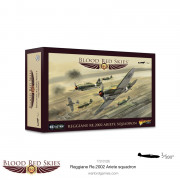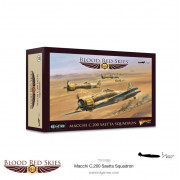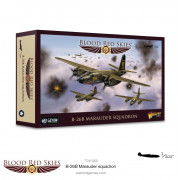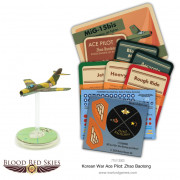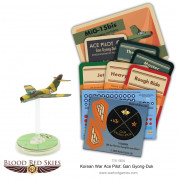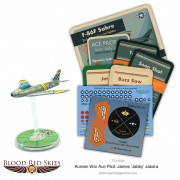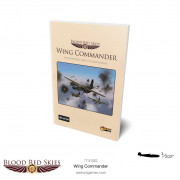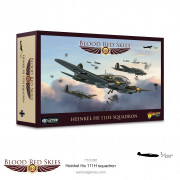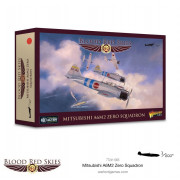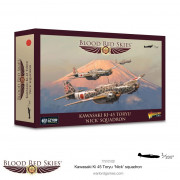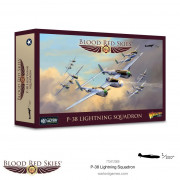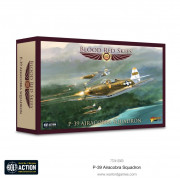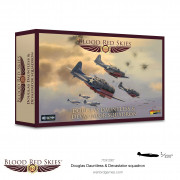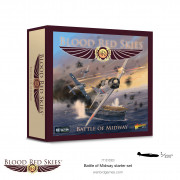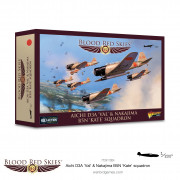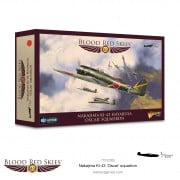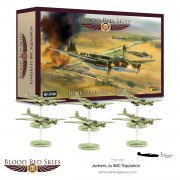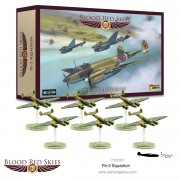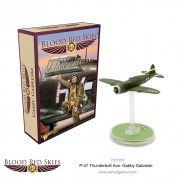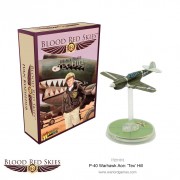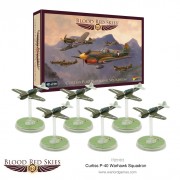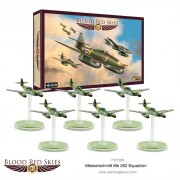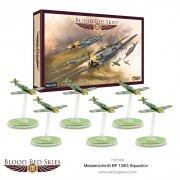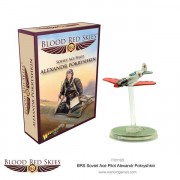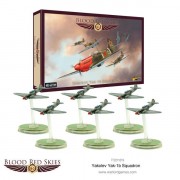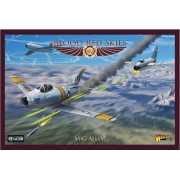Blood Red Skies
- Grid display
- List display
-
Blood Red Skies - Italian Ace Pilot Furio Niclot Doglio
17,50 €
This box contains the Italian Ace Pilot Furio Niclot Doglio plane, one stand and game components. Figure supplied unassembled and unpainted.
- English
17,50 €
Vendu par Philibert
-
Blood Red Skies - Macchi C.202 Folgore Squadron
34,95 €
This box contains 6 planes for Blood Red Skies, stands and game components. Figures supplied unassembled and unpainted.
- English
34,95 €
Vendu par Philibert
-
Blood Red Skies - Japanese Ace Pilot Yukiyoshi Wakamatsu
17,50 €
This box contains the Japanese Ace Pilot Yukiyoshi Wakamatsu plane, one stand and game components. To assemble and paint.
- English
17,50 €
Vendu par Philibert
-
Blood Red Skies - Nakajima Ki-84 Hayate 'Frank' Squadron
34,95 €
This box contains 6 planes for Blood Red Skies, stands and game components. Figures supplied unassembled and unpainted.
- English
34,95 €
Vendu par Philibert
-
Blood Red Skies - British Ace Pilot John Baldwin
17,50 €
This box contains the British Ace Pilot John Baldwin plane, one stand and game components. To assemble and paint.
- English
17,50 €
Vendu par Philibert
-
Blood Red Skies - Hawker Typhoon Squadron
34,95 €
This box contains 6 planes for Blood Red Skies, stands and game components. To assemble and paint.
- English
34,95 €
Vendu par Philibert
-
Blood Red Skies - Italian Ace Pilot Carlo Emanuele Buscaglia
17,50 €
The box "Italian Ace Pilot Carlo Emanuele Buscaglia" contains one figure and game accessories for Blood Red Skies.
- English
17,50 €
Vendu par Philibert
-
Blood Red Skies - Italian Ace Pilot Giuseppe Cenni
17,50 €
The box "Italian Ace Pilot Giuseppe Cenni" contains one figure and game accessories for Blood Red Skies.
- English
17,50 €
Vendu par Philibert
-
Blood Red Skies - Italian Ace Pilot Leonardo Ferrulli
17,50 €
The box "Italian Ace Pilot Leonardo Ferrulli" contains one figure and game accessories for Blood Red Skies.
- English
17,50 €
Vendu par Philibert
-
Blood Red Skies - Regia Aeronautica Expansion Pack
13,50 €
The box "Regia Aeronautica Expansion Pack" is an expansion for Blood Red Skies.
- English
13,50 €
Vendu par Philibert
-
Blood Red Skies - SM.79 Sparviero Squadron
32,50 €
The box "SM.79 Sparviero Squadron" contains three figures and game accessories for Blood Red Skies.
- English
32,50 €
Vendu par Philibert
-
Blood Red Skies - Reggiane Re.2002 Ariete Squadron
34,95 €
The box "Reggiane Re.2002 Ariete Squadron" contains six figures and game accessories for Blood Red Skies.
- English
34,95 €
Vendu par Philibert
-
Blood Red Skies - Macchi C.200 Saetta Squadron
34,95 €
The box "Macchi C.200 Saetta Squadron" contains six figures and game accessories for Blood Red Skies.
- English
34,95 €
Vendu par Philibert
-
Blood Red Skies - US Ace Pilot James Farrell
17,50 €
The box "US Ace Pilot James Farrell" contains one Ace figure for Blood Red Skies.
- English
17,50 €
Vendu par Philibert
-
Blood Red Skies - B-26B Marauder Squadron
31,95 €
The box "B-26B Marauder Squadron" contains three figures for Blood Red Skies.
- English
31,95 €
Vendu par Philibert
-
Blood Red Skies - Korean War Ace Pilot: Zhao Baotong
18,50 €
The box "Korean War Ace Pilot: Zhao Baotong" contains one Ace figure for Blood Red Skies: Korean War.
- English
18,50 €
Vendu par Philibert
-
Blood Red Skies - Korean War Ace Pilot: Gan Gyong-Duk
18,50 €
The box "Korean War Ace Pilot: Gan Gyong-Duk" contains one Ace figure for Blood Red Skies: Korean War.
- English
18,50 €
Vendu par Philibert
-
Blood Red Skies - Korean War Ace Pilot: John F. Bolt
18,50 €
The box "Korean War Ace Pilot: John F. Bolt" contains one Ace figure for Blood Red Skies: Korean War.
- English
18,50 €
Vendu par Philibert
-
Blood Red Skies - Korean War Ace Pilot: James ‘Jabby’ Jabara
18,50 €
The box "Korean War Ace Pilot: James ‘Jabby’ Jabara" contains one Ace figure for Blood Red Skies: Korean War.
- English
18,50 €
Vendu par Philibert
-
Blood Red Skies - Wing Commander Compendium
28,95 €
Blood Red Skies: Wing Commander Compendium is a rules compendium that presents all of the rules from the original Blood Red Skies starter set and adds many new ones.
- English
28,95 €
Vendu par Philibert
-
Blood Red Skies: Heinkel He 111H Squadron
31,95 €
Contains three Warlord Resin PlusTM Heinkel HE 111 bombers plus game accessories.
- English
- From 14 years old
31,95 €
Vendu par Philibert
-
Blood Red Skies: Japanese A6M2 Zero Squadron, 6 planes
34,95 €
The box "Blood Red Skies A6M2 Zero Squadron" contains 6 planes for Blood Red Skies. Figures supplied unassembled and unpainted.
- English
34,95 €
Vendu par Philibert
-
Blood Red Skies - Kawasaki Ki-45 Toryu 'Nick' Squadron
41,95 €
Box containing 6 planes for Blood Red Skies, bases and various game components. Supplied unassembled and unpainted.
- English
41,95 €
Vendu par Philibert
-
Blood Red Skies - P-38 Lightning Squadron
40,95 €
Box containing 6 planes for Blood Red Skies, bases and various game components. Supplied unassembled and unpainted.
- English
40,95 €
Vendu par Philibert
-
Blood Red Skies - P-39 Airacobra Squadron
34,95 €
Box containing 6 planes for Blood Red Skies, bases and various game components. Supplied unassembled and unpainted.
- English
34,95 €
Vendu par Philibert
-
Blood Red Skies - Douglas Dauntless & Devastator Squadron
35,50 €
Box containing 6 planes for Blood Red Skies, bases and various game components. To be assembled and painted.
- English
35,50 €
Vendu par Philibert
-
Blood Red Skies - The Battle of Midway - Starter Set
67,95 €
Blood Red Skies is a tabletop miniatures game in which you take command of a force of fighter planes in combat.
- English
67,95 €
Vendu par Philibert
-
Blood Red Skies - Aichi D3A 'Val' & Nakajima B5N 'Kate' Squadron
35,50 €
Box containing 6 planes for Blood Red Skies, bases and various game components. To be assembled and painted.
- English
35,50 €
Vendu par Philibert
-
Blood Red Skies - Nakajima Ki-43 II Hayabusa 'Oscar' Squadron
34,95 €
Box containing 6 planes for Blood Red Skies, bases and various game components. To be assembled and painted.
- English
34,95 €
Vendu par Philibert
-
Blood Red Skies - German Junkers Ju 88C Squadron, 6 planes
44,95 €
This box contains 6 planes for Blood Red Skies, stands and game components. To assemble and paint.
- English
44,95 €
Vendu par Philibert
-
Blood Red Skies - Soviet- Petliakov Pe-2 squadron, 6 planes
41,95 €
This box contains 6 planes for Blood Red Skies, stands and game components. To assemble and paint.
- English
41,95 €
Vendu par Philibert
-
Blood Red Skies - German Ace Pilot Walter Borchers
15,95 €
An Ace for Blood Red Skies, with a model and cards.
- English
15,95 €
Vendu par Philibert
-
Blood Red Skies: Soviet Ace Pilot Mariya Dolina
15,95 €
An Ace for Blood Red Skies, with a model and cards.
- English
15,95 €
Vendu par Philibert
-
Blood Red Skies - US Ace Pilot 'Gabby' Gabreski
15,95 €
This box contains 1 plane and cards. To assemble and paint.
- English
15,95 €
Vendu par Philibert
-
Blood Red Skies - US Ace Pilot 'Tex' Hill
15,95 €
This box contains 1 plane and cards. To assemble and paint.
- English
15,95 €
Vendu par Philibert
-
Blood Red Skies - German Ace Pilot Walter Nowotny
15,95 €
This box contains 1 plane and cards. To assemble and paint.
- English
15,95 €
Vendu par Philibert
-
Blood Red Skies - German Ace Pilot Erich Hartmann
17,50 €
This box contains 1 plane and cards. To assemble and paint.
- English
17,50 €
Vendu par Philibert
-
Blood Red Skies: Republic P-47 Thunderbolt Squadron, 6 planes
34,95 €
This box contains 6 planes and game aids. To assemble and paint.
- English
34,95 €
Vendu par Philibert
-
Blood Red Skies: Curtiss P-40 Warhawk Squadron, 6 planes
34,50 €
This box contains 6 planes and game aids. To assemble and paint.
- English
34,50 €
Vendu par Philibert
-
Blood Red Skies: Messerschmitt M262 Squadron, 6 planes
34,95 €
This box contains 6 planes and game aids. To assemble and paint.
- English
34,95 €
Vendu par Philibert
-
Blood Red Skies: Messerschmitt Bf 109G Squadron, 6 planes
34,95 €
This box contains 6 planes and game aids. To assemble and paint.
- English
34,95 €
Vendu par Philibert
-
Blood Red Skies: Soviet Ace Alexandr Pokryshkin
15,95 €
This blister contains one plane and cards. To assemble and paint.
- English
15,95 €
Vendu par Philibert
-
Blood Red Skies: Soviet Ace Vladimir Pokrovsky
15,95 €
This blister contains one plane and cards. To assemble and paint.
- English
15,95 €
Vendu par Philibert
-
Blood Red Skies: Soviet Ace Lev 'Sokol' Shestakov
15,95 €
This blister contains one plane and cards. To assemble and paint.
- English
15,95 €
Vendu par Philibert
-
Blood Red Skies - Soviet- Mikoyan-Gurevich MiG-3 Squadron, 6 Planes
34,95 €
This box contains 6 planes for Blood Red Skies, stands and game components. To assemble and paint.
- English
34,95 €
Vendu par Philibert
-
Blood Red Skies - Soviet- Yakolev Yak-1B Squadron, 6 Planes
34,95 €
This box contains 6 planes for Blood Red Skies, stands and game components. To assemble and paint.
- English
34,95 €
Vendu par Philibert
-
Blood Red Skies - Soviet- Polikarpov I-16 Squadron, 6 Planes
34,50 €
This box contains 6 planes for Blood Red Skies, stands and game components. To assemble and paint.
- English
34,50 €
Vendu par Philibert
-
Blood Red Skies - Korean War - Mig Alley!
22,50 €
This box contains 4 metal planes for Blood Red Skies Korea War, stands and game components.
- English
22,50 €
Vendu par Philibert
Copyright © 2025 www.philibertnet.com Legals - Privacy Policy - Cookie Preferences - Sitemap


